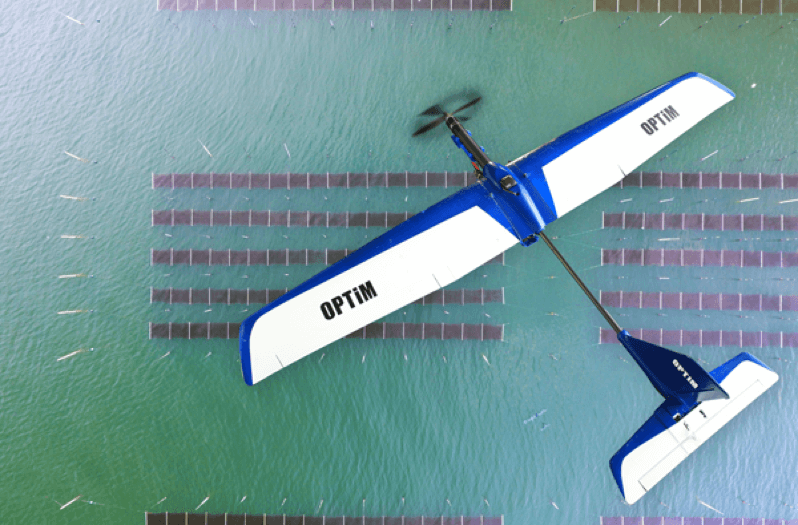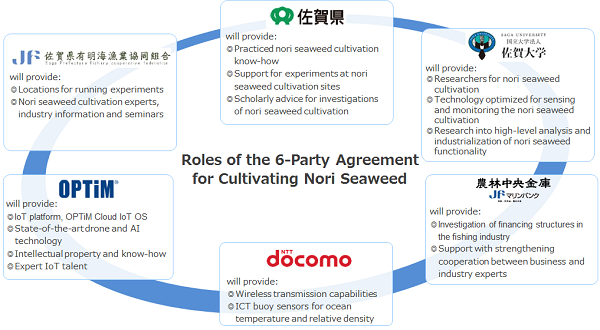RELEASE
March 15, 2017 (TOKYO, Japan)Release
Press Release
6-Party Agreement for Cultivating Nori Seaweed with IoT, AI, and Robots
Saga Prefecture, Saga University, Saga Prefecture Fishery Cooperative Federation,
The Norinchukin Bank, NTT DOCOMO and OPTiM
SAGA, Japan (March 15, 2017) - Saga Prefecture Department of Agriculture, Forestry and Fisheries (referred to hereafter as "Saga Prefecture"), the Faculty of Agriculture of Saga University (referred to hereafter as "Saga University"), Saga Prefecture Fishery Cooperative Federation, The Norinchukin Bank, NTT DOCOMO, INC., and OPTiM Corporation announce a 6-party cooperation agreement for utilizing IoT, AI, and robots in nori seaweed cultivation, the chief industry of the Saga seaside.
This initiative focuses on an IoT network to help nori cultivation. The network consists of drones, ICT buoys and smart devices. The resulting big data is then analyzed by AI to increase the quality and quantity of harvests, counter disease and reduce the labor required at fisheries.
The basis of this initiative is to predict outbreaks of nori seaweed-related diseases and algal bloom (red tide) through experiments and investigation. Included in these experiments is the world's first※1 LPWA※2 and cellular-transmission equipped winged drone, OPTiM Hawk. The drone will be used to collect big data along with ICT buoys※3 provided through NTT DOCOMO, and other equipment, and that data will be analyzed using AI.
■About 6-Party Nori Seaweed Cultivation with IoT ~ Industry 4.0 for Fisheries ~
Saga's Ariake marine area has been Japan's #1 producer by volume of nori seaweed for 13 years running. Here, the 6-party agreement will work together as specialists in their respective fields to improve nori seaweed crop quality and yields, predict disease outbreak and algal bloom, and decrease the amount of human labor needed on-site.
In 2015, Saga Prefecture, Saga University and OPTiM entered a three-party cooperation agreement to realize Industry 4.0 Agriculture. This 6-party agreement is an evolution of that previous initiative, and aims to provide Saga's top-quality nori seaweed to people worldwide.
■Outline of Experiments to be Conducted at the Saga Ariake Marine Area Nori Cultivation
-
Counteracting Disease (Red Rot Disease, etc.)
With sensor data collected from ICT buoys and aerial images from drones, OPTiM Cloud IoT OS will store and manage the big data, and then conduct analysis using AI. The analysis will try to detect conditions of where red rot disease starts, and the resulting information will be provided to others in the fisheries industry. -
Counteracting Algal Bloom (Red Tide)
OPTiM Cloud IoT OS will be used to create a map of algal bloom breakout sources, based on aerial images from drones. The resulting data will passed along to others in the fisheries industry to help combat algal bloom. Furthermore, water quality data from ICT buoys analyzed by AI could help find a relationship between that data and instances of algal bloom occurrence. -
OPTiM Hawk: the World's First LPWA and Cellular-Transmission Equipped Winged Drone
Joining AgriDrone, OPTiM's multi-copter drone, OPTiM Hawk is a fixed-wing drone equipped with NTT DOCOMO’s LTE and LPWA cellular transmission capabilities. Using these technologies, experiments on transmitting real-time data with an in-flight drone will be conducted.
◆Image of OPTiM Hawk

-
ICT Buoys and OPTiM Cloud IoT OS
OPTiM Cloud IoT OS can utilize the data collected from ICT Buoys provided through NTT DOCOMO. The data can be stored and managed, and then analyzed by AI to find insights to counteract the breakout of diseases and improve the quality of cultivation.
The following plan is scheduled to be conducted in the next year.
-
Counteracting "Barikan-sho" Disease (trimmed bud)
In the nori seaweed farms of the Ariake Sea, the tips of the thallus can be trimmed due to "Barikan-sho" Disease. There are two known causes; the first is due to damage from ducks eating the thallus, and the other is related to low salinity seawater. Efforts to drive ducks away will be conducted by drones with strategies such as having the drones let out a loud noise or by dropping food away from the nori seaweed farm. ICT buoys will be deployed to collect data on water quality such as salt concentration. With that data, water environments conductive to "Barikan-sho" Disease breakouts will be investigated.
■The Roles of each of the 6 Parties

◆Saga Prefecture will provide:
- Practiced nori seaweed cultivation know-how
- Support for experiments at nori seaweed cultivation sites
- Scholarly advice for investigations of nori seaweed cultivation
◆Saga University will provide:
- Researchers for nori seaweed cultivation
- Technology optimized for sensing and monitoring the nori seaweed cultivation
- Research into high-level analysis and industrialization of nori seaweed functionality
◆Saga Prefecture Fishery Cooperative Federation will provide:
- Locations for running experiments
- Nori seaweed cultivation experts, industry information and seminars
◆The Norinchukin Bank (as JF Marine Bank) will provide:
- Investigation of financing structures in the fishing industry
- Support with strengthening cooperation between business and industry experts
◆NTT DOCOMO will provide:
- Wireless transmission capabilities
- ICT buoy sensors for ocean temperature and relative density
◆OPTiM will provide:
- IoT platform, OPTiM Cloud IoT OS
- State-of-the-art drone and AI technology
- Intellectual property and know-how
- Expert IoT talent
■About OPTiM Cloud IoT OS
OPTiM Cloud IoT OS is an intuitive and secure IoT solution. It allows users to manage and control connected devices, collect and store data on the cloud, and run analysis and AI to uncover insights. A powerful asset for businesses in any industry, Cloud IoT OS brings value to IoT systems and data.
For more information about OPTiM Cloud IoT OS, please visit the site below:
https://www.optim.com/cloud-iot-os/
| ※1 | As of March 13, 2017, based on the research by OPTiM regarding drones equipped with LPWA and cellular transmission capabilities. |
| ※2 | LPWA stands for “low power wide area,” a general term that refers to a technology that allows for communication signals to be spread over a wide area while only consuming low amounts of electric power. |
| ※3 | An ICT buoy is a buoy equipped with transmission modules and sensors, and can send the collected data to the cloud. It is designed to work both when anchored and free-floating. |
【Copyright/Trademark】
※The corporate names and product names mentioned above are registered trademarks or trademarks.
※The information presented in this press release is subject to change without notice.
Inquiries
press@optim.co.jp TEL: +81-3-6435-8570 FAX: +81-3-6435-8560




